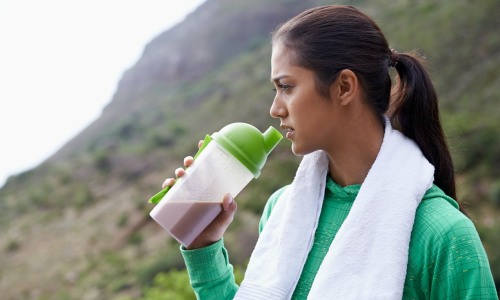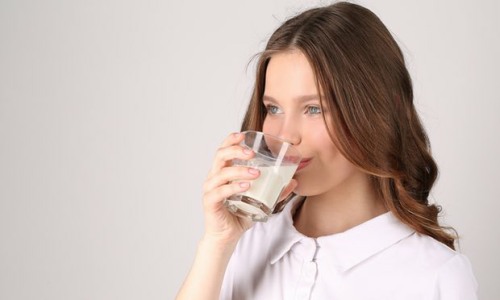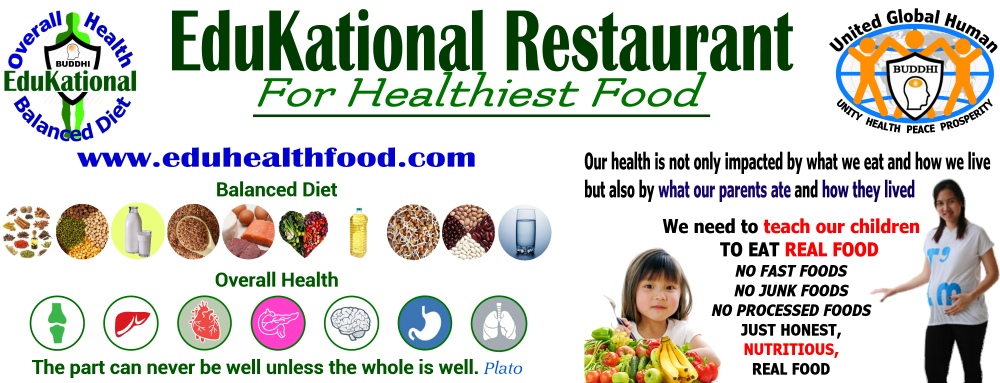
EduKational Health Article
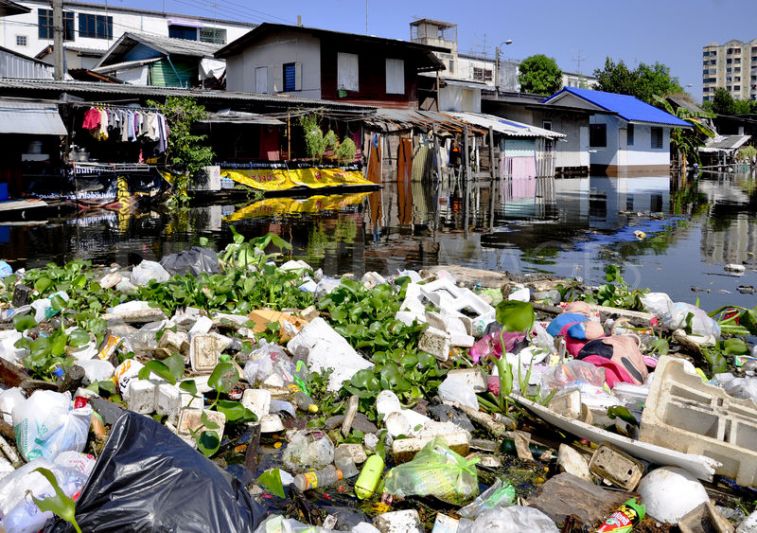
Waste plastic in Bangkok waterway
The Plastics Crisis
We are killing our world and ourselves with plastic waste
We have nothing to blame but ourselves and our 'throw away' society
A crisis of catastrophic proportions is washing up on our beaches and our waterways. As a result of our convenience 'throw away' society, plastics - that were thought to be the answer to societies search for convenience - are getting into the food chain and poisoning not only our marine life, our oceans, and our land, but ouselves as well.
Many plastics are not biodegradeable and take decades to break down. Even when they do break down they still pose a real problem as the residue is eaten by marine life and so enter the food chain. Many of these plastics are toxic.
The problem
"That means by 2050, the plastic in the world's oceans will weigh more than all the fish".
The Ellen MacArthur Foundation.
Humans have produced billions of tons of plastic since the invention of the first plastc - Bakelite - in 1947. Millions of tons of waste plastic have made their way into the worlsd's oceans since then. The latest prediction for waste plastic in our oceans say that it will soon outweigh the total of ALL fish in the oceans!
Over many years discarded waste plastics have found their way into rivers, canals, and other waterways; mainly due to irresponsible
waste management by Governments and careless disposal by corporations, companies, and individual people.
Despite efforts by Goverments to tackle the problem many people still do not understand the enormity of their actions and still
carelessly discard plastics into waterways. These waterways make their way to the seas and oceans.
Once plastic reaches open water it can be carried for thousands of miles, but it is more likely to join one of five huge circulating masses of water known as ocean gyres. Gyres are mainly made up of tiny fragments of plastic that build up over time.
These huge masses of plastic are found all over the world's oceans.
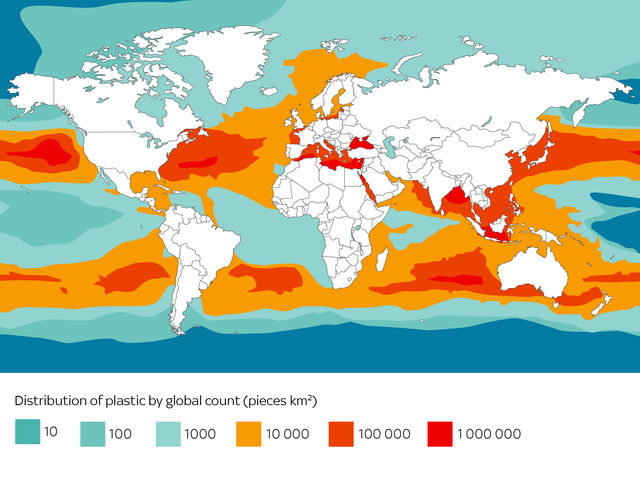
Source: Sky News - Ocean Rescue
Why does it matter?
Ultimately, we are eating the plastic we're dumping in the sea.
If someone asked you to take a bite out of your fizzy drink bottle what would you say? You'd almost certainly say no.
However, eat six oysters and the odds are you've swallowed 50 pieces of plastic.
Plastics contain phthalates, often found in glue, and bisphenol-A (BPA), which is also used to make DVDs. They are as bad for you as you think they are.
It gets worse. Floating plastic acts as a magnet for pesticides, flame retardants and other chemicals found in the ocean. These chemicals are known to disrupt human hormones and cause cancer.
"Oceans provide half the oxygen we breathe. They are the main source of protein for over a billion people.".
Thomas Moore
How does it end up in our food?
Floating plastic becomes brittle in sunlight and then slowly breaks up into ever-smaller pieces as it is churned up by waves. It can take centuries to break down. Many scientists believe plastic never completely disappears - particularly if it's submerged in deep or cold water.
A drink bottle can take 450 years to break down, while a plastic fishing line could last for 600 years.
So if Christopher Columbus had tossed some plastic overboard on his way to discover America in 1492, there would still be
fragments floating around the ocean today.
Plastic breaks down over time and could eventually end up on our dinner plate.
One study estimated there were almost 15 trillion pieces of microplastic in the ocean, but that figure could be as many as 51 trillion.
For marine animals, these particles are indistinguishable from their normal food. Even tiny plankton have been shown to feast on plastic.
The plastic then moves through the food-chain as small creatures are eaten by larger ones.
Up to 90% of seabirds have plastic in their stomachs.
Scientists can't say how dangerous plastic is to human health, but it's clear the effect on wildlife is devastating. Fish, whales, dolphins... hundreds of species have eaten plastic.

Turtle in waste plastic ring
Some seabirds and turtles have been found to have so much plastic in their stomach they can no longer eat the food they need to survive.
This affects their ability to migrate, mate and raise their young. Inevitably, they eventually die.
Discarded fishing gear is also killing marine wildlife, with one report estimating that 308,000 whales and dolphins die every year because they get tangled and drown.
What is the effect on Human health?
The following extract is from environmentalhealthnews.org
People are exposed to chemicals from plastic multiple times per day through the air, dust, water, food and use of consumer products.
For example, phthalates are used as plasticizers in the manufacture of vinyl flooring and wall coverings, food packaging and medical devices. Eight out of every ten babies, and nearly all adults, have measurable levels of phthalates in their bodies.
In addition, bisphenol A (BPA), found in polycarbonate bottles and the linings of food and beverage cans, can leach into food and drinks. The U.S. Centers for Disease Control and Prevention reported that 93 percent of people had detectable levels of BPA in their urine.
The report noted that the high exposure of premature infants in neonatal intensive care units to both BPA and phthalates is of "great concern."
Polybrominated diphenyl ethers or PBDEs, which are flame-retardants added to polyurethane foam furniture cushions, mattresses, carpet pads and automobile seats, also are widespread.
The plastics industry maintains that its products are safe after decades of testing.
"Every additive that we use is very carefully evaluated, not just by the industry, but also independently by government agencies to look at all the materials we use in plastics," said Mike Neal, a consumer and environmental affairs specialist at PlasticsEurope, an industry trade association, and a co-author of the report.
But some of these chemicals have been shown to affect reproduction and development in animal studies, according to the report. Some studies also have linked these chemicals with adverse effects in people, including reproductive abnormalities.
"We have animal literature, which shows direct links between exposure and adverse health outcomes, the limited human studies, and the fact that 90 to 100 percent of the population has measurable levels of these compounds in their bodies," said John Meeker, an assistant professor of environmental health sciences at the University of Michigan School of Public Health and a lead author. "You take the whole picture and it does raise concerns, but more research is needed."
Shanna Swan, director of the University of Rochester's Center for Reproductive Epidemiology, conducted studies that found an association between pregnant women’s exposure to phthalates and altered genital development in their baby boys.
Also, people with the highest exposure to BPA have an increased rate of heart disease and diabetes, according to one recent study. Animal tests studies of PBDEs have revealed the potential for damaging the developing brain and the reproductive system.
Yet the effects on human health remain largely unknown. To help shed more light on the issue, the report recommends more sophisticated human studies.
"It’s tough to have a smoking gun with a single animal study or observational human study," Meeker said. "We need to have different types of studies indicating a consistent pattern to more definitively determine health effects resulting from these chemicals."
But testing humans for endocrine disruptors can be tricky because phthalates and BPA pass through the body so quickly. In addition, tests for each chemical cost about $100 a pop.
Deciding which chemicals to test and at what dose is also an issue. To date, most studies have addressed single chemicals, and there are limited data on the interactions between chemicals. Compounding the problem is the discovery that endocrine disrupting chemicals may have effects at doses lower than those used in the Environmental Protection Agency’s standard toxicity tests.
Swan said the old model of testing should be thrown out and that the new goal should be tests that mimic real human exposure.
"It’s a very complicated picture and the laboratory model of just taking one isolated chemical and giving it to a genetically pure strain of rats in clean cages, clean air and clean water and seeing what it does just doesn't come close to mimicking the human situation," she said.
Many researchers recommend studies that test pregnant women as well as their children. The National Children’s Study will do just that by examining environmental influences on more than 100,000 children across the United States, following them from before birth until age 21.
"There are so many questions now with these chemicals in relation to cardiovascular disease, age and puberty, obesity, developmental disorders," said Swan. "We don't know what’s causing it, only hints, so the beauty of the National Children’s Study is that we can look at all of these endpoints and it should reveal a lot of answers."
Some disturbing facts about plastics
- Over the last ten years we have produced more plastic than during the whole of the last century.
- 50 percent of the plastic we use, we use just once and throw away.
- Enough plastic is thrown away each year to circle the earth four times.
- We currently recover only five percent of the plastics we produce.
- The average American throws away approximately 185 pounds of plastic per year.
- Plastic accounts for around 10 percent of the total waste we generate.
- The production of plastic uses around eight percent of the world’s oil production (bioplastics are not a good solution as they require food source crops).
- Americans throw away 35 billion plastic water bottles every year (source: Brita)
- Plastic in the ocean breaks down into such small segments that pieces of plastic from a one liter bottle could end up on every mile of beach throughout the world.
- Annually approximately 500 billion plastic bags are used worldwide. More than one million bags are used every minute.
- 46 percent of plastics float (EPA 2006) and it can drift for years before eventually concentrating in the ocean gyres.
- It takes 500-1,000 years for plastic to degrade.
- Billions of pounds of plastic can be found in swirling convergences in the oceans making up about 40 percent of the world’s ocean surfaces. 80 percent of pollution enters the ocean from the land.
- The Great Pacific Garbage Patch is located in the North Pacific Gyre off the coast of California and is the largest ocean garbage site in the world. This floating mass of plastic is twice the size of Texas, with plastic pieces outnumbering sea life six to one.
- Plastic constitutes approximately 90 percent of all trash floating on the ocean’s surface, with 46,000 pieces of plastic per square mile.
- One million sea birds and 100,000 marine mammals are killed annually from plastic in our oceans.
- 44 percent of all seabird species, 22 percent of cetaceans, all sea turtle species and a growing list of fish species have been documented with plastic in or around their bodies.
- In samples collected in Lake Erie, 85 percent of the plastic particles were smaller than two-tenths of an inch, and much of that was microscopic. Researchers found 1,500 and 1.7 million of these particles per square mile.
- Virtually every piece of plastic that was ever made still exists in some shape or form (with the exception of the small amount that has been incinerated).
- Plastic chemicals can be absorbed by the body—93 percent of Americans age six or older test positive for BPA (a plastic chemical).
- Some of these compounds found in plastic have been found to alter hormones or have other potential human health effects.
"The ultimate goal is to change the mindset about plastics. What was once the answer to every household's endless supply of dirty dishes, is now the problem washing up on every shore in the world, showing up in the stomachs of every animal, and poisoning our waterways.".
plastictides.org
What can we ordinary people do?

Plastic waste washed up on beach
We can ALL make a difference. The first, and most important thing, is to change our mindset about why and how we use plastics; is the convenience of plastic worth the damage caused by its irresponsible disposal.
We can reduce our use of disposable plastic items, especially 'one-use' items, such as plastic carrier bags, drinking straws, food, drinks and beverage containers (all cardboard food and drink containers are coated inside and out with plastic).
The best solutions for our plastic problem are still to reduce our use of plastics, and to reuse and recycle whenever possible.
- Re-use plastic carrier bags
or, better still, don't use plastic bags at all. - Don't use plastic drinking straws
- Don't buy water in plastic bottles
- Don't buy pre-packaged 'convenience' foods
- Ensure we all dispose of any waste plastic responsibly.
Comment:
EduKational Restaurant wholeheartedly endorses the campaigns to clean up the world's oceans to save our world, wildlife, environment, and our own health for the sake of future generations.
At EduKational we do not use plastics; all our foods are sourced locally to ensure freshness, nutritional value, and to reduce our carbon footprint.
We earnestly encourage all our customers and friends to play their part in this struggle by following honest advice from respected researchers and activists. Do not be fooled by the big industries and manufacturers who have vested interests in making us use plastics against our will.
We encourage our Governments to ensure that the industries play their part in tackling this crisis and do not pass on costs to the public in the form of higher prices.
We also urge Government to ensure that suffiecient resources are in place to safely and efficiently dispose of plastic waste to ensure that it does not get into the food cahin.
Lastly, EduKational makes a plea to you, our honest, caring, responsible citizens, to spread the word about the dangers of irresponsible disposal
of plastic waste to our own friends and neighbors.
We CAN make a difference but we need to act fast; Let us ALL do our bit TODAY.
References:
22 facts about plastic pollution and 10 things we can do about it
Environmental Health News.org - Dangers of Plastic
